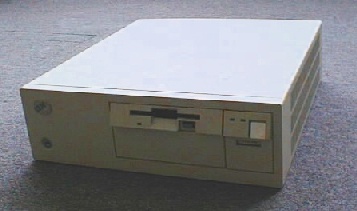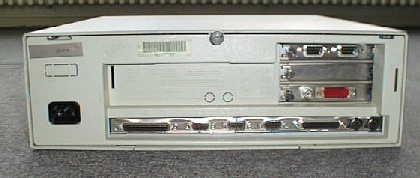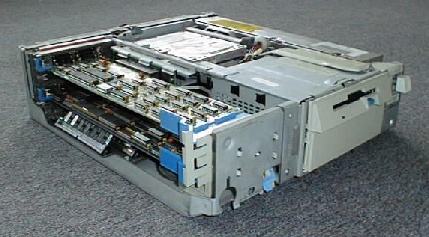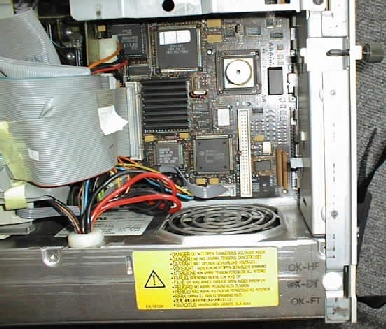
Click here or click onto the photo for a full size version of this picture.
The 486SLC2 was IBM's final strike to build 386SX-pinout-compatible CPUs after they made the 386SLC. Like the 386SLC, it has 16 KBytes of on-chip cache, but additionally, it has an internal clock doubler and a new CPU core that executes a couple of instructions in 486-like clock counts. Of course, the external bus interface is still the same as for a 386SX25, so you shouldn't expect the same performance as from a true 486DX2/50, but the relatively large internal cache assures that not too much gets lost. For real-world computations like the RC5 client that fits mostly into the cache, approximately the performance of a 33MHz-486 is reached (of course less if your application is floating-point or memory-intensive...).
IBM also upgraded the on-board graphics from a simple VGA controller to an accelerated XGA-2 graphics processor which is nicely supported by OS/2. It should work also with Linux' AGX driver, but I haven't had too much luck with it up to now...

Click here or click onto the photo for
a full size version of this picture.
The back side shows the beautiful amount of peripherals already integrated into the main board. From left to the right, there is the external SCSI connector (proprietary 60-pin mini centronics), video, two serial ports, parallel port and keyboard/mouse. The two round break-out holes above the serial ports are for a mechanical extension: you could get an U-shaped bolt from IBM that is large enough to pull a chain through it; this way, you could fix your expensive PS/2 machine to the table or wall and make it substantially more difficult to steal 8-)

Click here or click onto the photo for
a full size version of this picture.
What I really admire about all model 56s/76s is how good IBM exploited the available space. Apart from the floppy, there is an internal bay for a 3,5 inch, 1 inch height hard drive, good for a couple of gigabytes these days, and at the front another bay for a 5,25-inch drive. I currently have a 300M SCSI disk in it, but a CD-ROM would also be a nice option.
There are slots for three microchannel boards, with the usual trick of rotating them by 90 degrees because the case is not tall enough. Given what is already on-board, three slots aren't few, and the only extension I wouldn't want to miss is the Ethernet card; a third and fourth serial port are already luxury.
The machine has three sockets for PS/2 true parity SIMMs; you may put in an arbitrary mixture of 4M and 8M modules. If the memory adds up to more than 16Mbytes, you get a warning that additional memory can't be used (remember the 486SLC2 technically is only a 386SX with 24 address lines). To save space and fit under the cards, they're rotated by 45 degrees.
A tricky detail is the blue microswitch at the front: if you remove the cover, the switch will go down and disable the power switch (the power supply has an additional 5V standby line and allows turning on and off via low-voltage switches). If you want to run the machine with the cover off, you have to push it up again manually....

Click here or click onto the photo for
a full size version of this picture.
After removing the internal hard drive, the part of the main board holding the CPU becomes visible. It's the small PQFP case below the video memory chips. A nice difference to its predecessor, the 386SLC, is the fact that it doesn't need additional cooling plates. The chip that needs cooling is the XGA-2 graphics controller.
- Processor:
- IBM 486SLC2 @ 50 MHz
- Coprocessor:
- IIT 3C87SX @ 25 MHz
- Cache:
- 16K internally in CPU
- Memory:
- 16 Mbytes (options range from 4M to 16M)
- Bus:
- 3 MCA slots (16 bit)
- Interfaces (onboard):
-
- Mouse, Keyboard
- 2 x Serial
- 1 x Parallel
- Floppy (2.88M), allows attachment of up to 3(!) drives
- SCSI (narrow)
- XGA-2
- Add-on cards:
-
- SKnet Junior MC2 Ethernet adapter
- IBM Dual Serial Adapter
- Operating System(s):
-
- OS/2 Warp Version 3
- Caldera OpenDOS 7.01
- Linux 2.2 (Slackware-based)
- Useful Links: